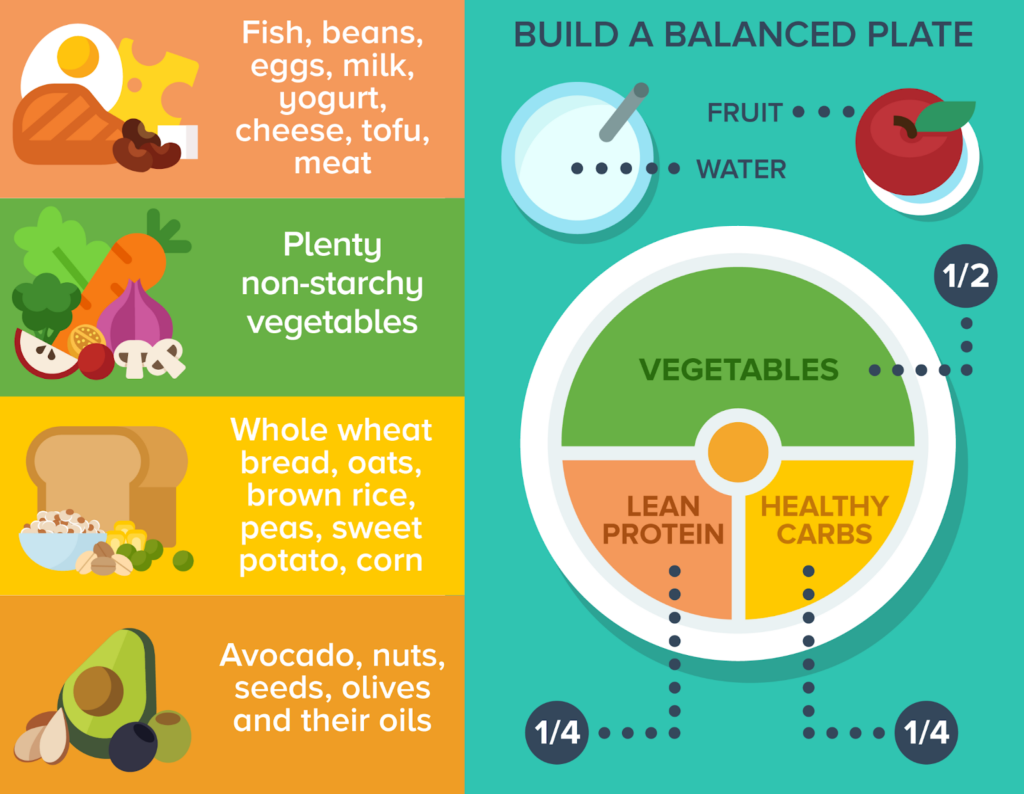
Building a well-balanced plate is essential for promoting good health, managing weight, and reducing the likelihood of chronic diseases. This means incorporating the right proportions of various food groups to ensure your body receives all the necessary nutrients. Here’s a comprehensive guide on how to build your balanced plate effectively.
What Is a Balanced Plate?
A balanced plate combines macronutrients – carbohydrates, proteins, and fats along with vitamins and minerals from foods such as fruits and vegetables. For any person of any age group, the goal is to create meals that are satisfying, nourishing, and support overall well-being without precise counting of calories or eliminating any of the food groups.
Main Components of a Balanced Plate
A plate is always called a standard meal plate size, not too small or too big.

1. Half Your Plate: Vegetables and Fruits
Always focus on filling half the plate with a variety of colorful vegetables and fruits. They provide essential vitamins, minerals, fiber, and antioxidants. Focus on diversity and vibrant colors to maximize nutrient intake. Be aware of starchy vegetables like potatoes or sweet potatoes, which have higher carbohydrate content than normal vegetables. They should not count as part of this half because of their impact on blood sugar, but plan to include them within daily total carbohydrate intake.
2. One-Quarter: Whole Grains
Choose whole grains such as brown rice, quinoa, oats, whole wheat pasta, or millets. Whole grains have more fibre, and other nutrients than refined grains and help regulate blood sugar levels. Fiber also contributes to heart health and weight management.
3. One-Quarter: Protein
Include healthy protein sources like fish, poultry, soya, beans, lentils, nuts, paneer, or tofu. Though not necessary to avoid, limit foods such as red meat and processed meats significantly to reduce health risks. Protein is essential for many vital functions which including building new tissues, supporting muscle repair, immune function, and provide satiety.
4. Healthy Fats
Incorporate small amounts, such as a thumb-sized amount of healthy fats, such as cold-pressed oils, nuts, seeds, avocado, and fatty fish. These fats are essential in producing hormones, help absorb fat-soluble vitamins (A, D, E, K), and provide long-lasting energy.
How to Build Your Plate Step-By-Step
Step 1: Start with fiber-rich carbs: Whole grains or nutrient-dense starchy vegetables like sweet potatoes.
Step 2: Add in protein: Beans, lentils, fish, chicken, or plant-based proteins.
Step 3: Load up on veggies half of the plate: Dark leafy greens, carrots, all green vegetables, and other colorful ones that provide high antioxidants.
Step 4: Healthy fats: Use a teaspoon or drizzle oil and add nuts or avocado.
Step 5: Mix for the flavor: Use fresh herbs and spices to enhance taste without extra calories.
Benefits of Eating a Balanced Plate
The benefits of eating a balanced plate are as follows:
- Disease Prevention: It strengthens the immune system and reduces the risk of chronic diseases like diabetes, heart disease, and certain cancers.
- Weight Control: It supports healthy and sustainable weight management, avoiding the need for fad diets.
- Improved Mental Health: Proper nutrition is vital for brain function and can alleviate symptoms of depression and anxiety.
- Better Growth and Development: Adequate nutrients are crucial for the healthy growth of children and adolescents.
- Enhanced Body Appearance: A balanced intake of nutrients contributes to healthier skin, hair, and overall vitality.
Conclusion
Building a balanced plate is a simple and effective way to nourish your body and promote long-term health. By filling half your plate with vegetables and fruits, a quarter with whole grains, and a quarter with healthy protein, plus adding healthy fats, you create meals that are both satisfying and nutrient-rich.
Remember, balance and variety are key, and it’s about what you do most of the time, not perfection. Use visual guides like the Healthy Eating Plate to help plan your meals and enjoy the benefits of a well-rounded diet.
References:
The Deliciously Balanced Plate Infographic
Passi, S. J. (2024). Dietary Guidelines for Indians-2024: A Critical Appraisal. Journal of the Epidemiology Foundation of India, 2(4).
Author: Praveena Kuchipudi (INFS Faculty)